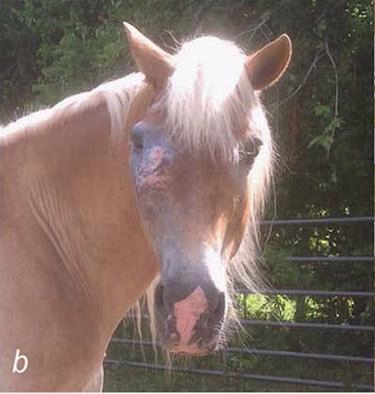Genetic risk factor for equine eye cancer identified

Squamous cell carcinoma (SCC) is the most common cancer found in equine eyes and the second most common tumor of the horse overall. Thanks to a recent genetic study led by UC Davis, horse owners can now identify horses at risk for ocular SCC and make informed breeding decisions.
In the cover article for the International Journal of Cancer, scientists announced the discovery of a genetic mutation in horses that is hypothesized to impact the ability of damage specific DNA binding protein 2 (DDB2) to carry out its standard role. Normally, the protein conducts DNA surveillance, looking for UV damage and then calling in other proteins to help repair the harm.
"The mutation is predicted to alter the shape of the protein so it can't recognize UV-damaged DNA," said Dr. Rebecca Bellone, an equine geneticist at the Veterinary Genetics Laboratory and associate adjunct professor at UC Davis School of Veterinary Medicine. "We believe this is a risk factor because cells can't repair the damage and accumulate mutations in the DNA that lead to cancer."
Several equine breeds, including Haflingers, have a higher occurrence of limbal SCC, the form of the disease that originates in the junction between the cornea—the clear surface of the eyeball—and the conjunctiva that covers the white of the eye. A former study, conducted by Bellone and one of her research partners, Dr. Mary Lassaline, found that about 26 percent of SCC-affected horses in a retrospective study were Haflingers.
"The fact that we see this type of cancer in a relatively small breed with a narrow pedigree makes it a good model to study," said Lassaline, associate professor of clinical equine ophthalmology at the UC Davis School of Veterinary Medicine.
Ocular SCC can lead to vision loss and even loss of the eye. In advanced cases, SCC can be locally invasive and spread to the orbit and eat away at bone and eventually the brain—leading to loss of life. These recent study results offer a huge application in identifying horses at risk for developing SCC on two fronts.
"One, it's important for the individual horse with a known risk and we can be more vigilant about exams as well as protecting their eyes from UV exposure," Lassaline said. "If detected early, we can remove the tumor and save the eye. Secondly, that knowledge is important for making informed breeding decisions."
Scientists at the UC Davis Veterinary Genetics Laboratory were able to develop a genetic test for horses based on the research. The test determines if a horse carries the mutation or has two copies of the risk variant, putting it at highest risk for cancer.
In addition to improving the health of horses, this study may have implications for human health as well. The gene found to be associated with equine SCC is also linked in humans to xeroderma pigmentosum complementation group E—a disease characterized by sun sensitivity and increased risk of cutaneous SCC and melanoma.
"There is an interesting parallel in humans with mutation in this protein," Bellone said. "Now we have the ability to understand why it's affecting the eyes of horses as well as the skin of humans."
Journal information: International Journal of Cancer
Provided by UC Davis
















